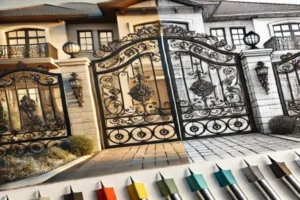Antique iron gates have long been a symbol of elegance and craftsmanship, showcasing intricate designs that reflect the architectural trends of their time. These gates not only serve as functional entryways but also as artistic expressions of the era in which they were created. Their timeless charm lies in the detailed ironwork that has stood the test of time, making them sought-after features in both historic and modern properties.
Restoring antique iron gates is more than just a cosmetic endeavor; it’s a way to preserve a piece of history. These gates often carry stories and significance that go beyond their aesthetic appeal. However, as much as they are valued for their historical essence, there is often a need to modernize them to meet contemporary standards and functionality. The challenge lies in striking the right balance—restoring these gates to their former glory while incorporating modern elements that do not detract from their original character. This process ensures that the gates remain a testament to their past while seamlessly fitting into the present.
Understanding the Historical Significance
Antique iron gates are more than just barriers; they are a testament to the rich history and skilled craftsmanship of past eras. Each gate tells a story, often reflecting the architectural style and social norms of the time in which it was created. Whether designed with intricate floral patterns or bold geometric shapes, these gates were often handcrafted by artisans who dedicated countless hours to perfecting every detail. The ironwork itself showcases the technological advancements of its period, from hand-forged designs to early industrial techniques that allowed for more intricate and elaborate patterns. This legacy of craftsmanship is what makes antique iron gates so valuable and cherished by collectors and homeowners alike.
Preserving antique iron gates is not merely about maintaining an aesthetic piece of history; it’s about safeguarding the cultural and architectural heritage that these gates embody. They are physical reminders of the past, often representing the grandeur and artistry of bygone eras. By preserving the original elements of these gates, we honor the traditions and skills of the artisans who created them. Moreover, maintaining these gates in their original form helps retain the historical integrity of the buildings and properties they adorn. In a world where modern design often favors simplicity, the elaborate details of antique iron gates offer a unique connection to a time when craftsmanship was highly valued, making their preservation all the more important.
Assessing the Condition of Your Antique Iron Gate
Before embarking on the restoration process, it’s crucial to thoroughly assess the current condition of your antique iron gate. Over the years, these gates are exposed to various elements, leading to common issues that must be addressed to ensure successful restoration.
One of the most prevalent problems with antique iron gates is rust. Iron is highly susceptible to oxidation, especially if the gate has not been properly maintained or coated. Rust can not only tarnish the appearance of the gate but also weaken its structural integrity. Additionally, wear and tear from years of use can cause hinges to loosen, screws to corrode, and certain parts of the gate to become misaligned. Structural damage, such as bent bars or broken decorative elements, is another common issue that needs careful attention during the assessment phase.
To accurately evaluate the condition of your antique iron gate, start with a close visual inspection. Look for visible signs of rust, corrosion, and any loose or missing components. Use a small hammer or similar tool to gently tap the iron in different areas—this can help identify weakened sections that may need reinforcement or replacement. It’s also important to check the stability of the gate by gently moving it to see if it wobbles or makes unusual sounds, which could indicate structural issues. For areas that are difficult to assess visually, consider using a wire brush to remove surface rust and reveal the underlying metal. This will help you better understand the extent of any damage and plan the necessary restoration steps accordingly.
Restoration Techniques to Preserve Originality
Restoring an antique iron gate requires a delicate balance between reviving its original beauty and preserving its historical integrity. The following techniques focus on cleaning, repairing, and protecting the gate while ensuring that its antique essence remains intact.
Cleaning and Rust Removal
The first step in restoring an antique iron gate is thorough cleaning and rust removal. Begin by using a soft brush or cloth to remove loose dirt and debris from the surface. For rust removal, it’s important to choose methods that won’t damage the underlying material. A wire brush can be effective for gently scrubbing away rust, while fine-grit sandpaper can be used to smooth out any rough spots. In cases where rust is more extensive, a rust converter can be applied to neutralize the rust and prevent further corrosion. It’s crucial to avoid harsh chemicals or abrasive tools that could strip away the original patina, as this can diminish the gate’s historical value.
Repairing and Replacing Parts
When it comes to repairing or replacing parts of an antique iron gate, the goal is to maintain as much of the original material as possible. Minor repairs, such as tightening loose screws or realigning hinges, can often be done without altering the gate’s appearance. For more significant damage, such as broken bars or missing decorative elements, consider having replacement parts custom-made to match the original design. It’s essential to work with a skilled metalworker who understands the importance of preserving the gate’s historical character. If replacement is necessary, ensure that the new parts are made from similar materials and finished in a way that blends seamlessly with the existing structure.
Protective Coatings
Applying a protective coating is the final step in the restoration process, helping to safeguard the gate from future damage while maintaining its antique appearance. A rust-inhibiting primer should be applied first to create a barrier against moisture and oxidation. Once the primer is dry, a high-quality paint designed for metal surfaces can be used to provide additional protection. It’s important to choose a paint color that complements the gate’s original look—opting for a matte or satin finish can help preserve its antique charm. For those who prefer to keep the natural iron finish, a clear sealant can be applied to protect the metal without altering its appearance. Regular maintenance, including periodic reapplication of the protective coating, will help ensure that the gate remains in excellent condition for years to come.
Modernizing Without Compromising the Essence
Restoring an antique iron gate doesn’t mean it has to remain entirely rooted in the past. With thoughtful modernization, you can introduce subtle updates that enhance the gate’s functionality and security while still preserving its historical charm. The key is to integrate these modern elements in a way that complements, rather than overshadows, the gate’s original design.
Incorporating Modern Elements
When modernizing an antique iron gate, consider adding features that enhance its practicality without detracting from its vintage appeal. One way to do this is by installing discreet security upgrades, such as a hidden latch system or reinforced hinges that provide additional strength. For those interested in automation, consider integrating an electric opener that allows the gate to be operated remotely, while keeping the mechanism hidden to maintain the gate’s traditional look. Lighting can also be a tasteful addition—small, strategically placed LED lights can illuminate the gate and surrounding area, providing both aesthetic appeal and improved security, all while being barely noticeable during the day.
Blending Old and New
Achieving a harmonious blend of old and new requires careful attention to detail. When choosing materials for any additions or repairs, opt for those that closely match the original ironwork. For instance, if you’re adding a modern element like a keypad entry system, consider encasing it in a decorative ironwork box that mirrors the gate’s original design. This ensures that the new feature doesn’t stand out as an eyesore but instead blends seamlessly with the gate’s aesthetic. Color is another important factor—any new elements should be painted or finished in a way that complements the existing patina of the gate. By carefully selecting materials and finishes that respect the gate’s historical character, you can successfully merge modern functionality with timeless design, creating a gate that serves both as a practical entryway and a preserved piece of history.
Maintenance Tips for Longevity
Once your antique iron gate has been restored, ongoing maintenance is crucial to ensure it remains in excellent condition for years to come. With regular care and attention, you can protect your gate from the elements and preserve its beauty and structural integrity for generations.
Regular Inspection and Care
To keep your antique iron gate in top shape, it’s important to conduct regular inspections. At least twice a year, carefully examine the gate for any signs of rust, wear, or damage. Pay particular attention to joints, hinges, and any areas where water might collect, as these are often the first places where corrosion begins. If you notice any rust starting to form, address it immediately by lightly sanding the affected area and applying a rust-inhibiting primer, followed by a touch-up of matching paint or sealant. Lubricating the hinges and other moving parts with a high-quality metal lubricant will prevent squeaking and ensure smooth operation. Regular cleaning with mild soap and water will also help remove dirt and grime, keeping the gate looking its best.
Seasonal Maintenance Routines
Different seasons bring different challenges for maintaining your antique iron gate, so it’s important to tailor your care routine accordingly. In the winter, snow and ice can accelerate rust formation, so be sure to clear any snow from the gate and avoid using harsh de-icing chemicals that can damage the metal. Applying a fresh coat of protective sealant before winter sets in can provide an extra layer of defense against moisture. In the spring, check for any damage caused by winter weather and make necessary repairs. The warmer months of summer are a good time to repaint or re-seal the gate if needed, as the dry weather helps the coatings cure properly. Finally, in the fall, clear away leaves and debris that could trap moisture against the gate’s surface, and inspect the gate to ensure it’s ready to withstand the coming winter. By following these seasonal maintenance routines, you can protect your antique iron gate from environmental damage and ensure it remains a beautiful and functional part of your property for years to come.
Conclusion
Restoring and modernizing an antique iron gate is a delicate process that requires careful planning and execution. From assessing the gate’s condition and addressing common issues like rust and structural damage, to implementing thoughtful restoration techniques that preserve its originality, every step is crucial in maintaining the gate’s historical charm. Incorporating modern elements, when done with care, can enhance the gate’s functionality without compromising its timeless appeal. Finally, ongoing maintenance, tailored to the changing seasons, ensures that your gate will continue to stand as a beautiful and functional piece of history for generations to come.
As you embark on the restoration journey, it’s important to approach the task with a deep respect for the gate’s history and the craftsmanship that went into its creation. Antique iron gates are not just functional objects; they are works of art that tell the story of a bygone era. By honoring the original design and materials while carefully integrating modern updates, you can breathe new life into the gate without losing the essence that makes it unique. Whether you’re restoring a family heirloom or a historic property feature, your efforts will ensure that this piece of history remains a treasured part of your home for years to come.




